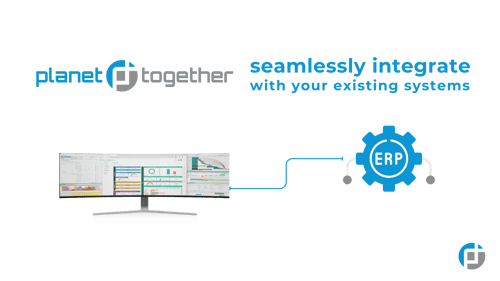Topics: PlanetTogether Software, Integrating PlanetTogether, Real-Time Data Exchange, Medical Manufacturing, Identify bottlenecks, Improved Service Levels, Better Forecast Alignment, Automated Constraint Consideration, Regulatory Documentation Sync

In the medical manufacturing sector, the margin for error is almost nonexistent. From surgical tools to diagnostic equipment and critical care devices, the stakes are high, timelines are tight, and regulatory scrutiny is intense. For Production Planners, ensuring a steady flow of raw materials, components, and finished products isn't just about efficiency—it’s about safeguarding patient lives and maintaining regulatory compliance.
Supply chain optimization, therefore, is not a luxury—it’s a necessity. And in today's data-driven manufacturing environment, achieving true optimization requires more than spreadsheets and manual planning. It demands robust tools like PlanetTogether Advanced Planning and Scheduling (APS) integrated with ERP systems such as SAP, Oracle, Microsoft Dynamics, Kinaxis, or Aveva.
Before looking into solutions, it’s essential to understand the multifaceted challenges confronting Production Planners:
Complex Bills of Materials (BOMs): Medical products often consist of hundreds of parts sourced globally, increasing the risk of disruption.
Demand Volatility: Forecasting can be complicated by sudden shifts in hospital demand, pandemic-driven usage, or changes in healthcare regulations.
Strict Compliance Requirements: Every batch, process, and component must meet stringent quality and documentation standards.
Limited Inventory Buffers: Just-in-time practices leave little room for delays or errors.
Multi-site Coordination: Globalized production often involves planning across several facilities and suppliers.
Optimizing supply chain performance requires a solution that brings visibility, flexibility, and speed to the production planning process. That’s where PlanetTogether APS and ERP integration come into play.

PlanetTogether APS is purpose-built for dynamic and complex manufacturing environments like medical device production. It enables planners to:
Simulate multiple production scenarios for proactive decision-making
Balance capacity and demand across lines and sites
Identify bottlenecks before they become disruptions
Optimize resource utilization including labor, machines, and materials
Improve on-time delivery metrics through predictive insights
When integrated with enterprise ERP systems—SAP, Oracle, Microsoft Dynamics, Kinaxis, or Aveva—the result is a synchronized planning ecosystem that eliminates data silos and empowers real-time optimization.

One of the most critical enablers of supply chain optimization is seamless integration between PlanetTogether APS and your existing ERP platform. Here's how this union enhances performance:
Real-Time Data Exchange
Integration ensures a continuous flow of information between the planning engine and enterprise-wide systems. Material availability, work orders, inventory levels, purchase requisitions, and supplier delivery timelines are all visible in one interface.
Better Forecast Alignment
With demand signals flowing from ERP systems like Oracle or Kinaxis into PlanetTogether APS, planners can align production schedules with the most up-to-date forecasts and sales commitments.
Automated Constraint Consideration
Integrated systems automatically account for machine availability, labor constraints, maintenance schedules, and raw material limitations—helping avoid overpromising and underdelivering.
Regulatory Documentation Sync
In regulated industries like medical manufacturing, having synchronized documentation between production schedules and ERP-controlled quality systems is crucial for audits and traceability.

A tightly optimized supply chain brings tangible benefits across operations:
Improved Service Levels
Ensure critical products are delivered on time, reducing backorders and enhancing customer satisfaction.
Lower Operating Costs
Optimize batch sizes, reduce overtime, and avoid expedited shipping fees driven by poor planning.
Higher Compliance Confidence
Support stringent documentation, serialization, and batch traceability needs with synchronized systems.
Increased Agility
Respond faster to changes in demand, supplier delays, or production disruptions with real-time what-if scenario modeling.
Better Collaboration
Cross-functional teams—from procurement to QA—gain access to consistent, shared data for cohesive decision-making.
In the high-stakes environment of medical manufacturing, Production Planners have a pivotal role in ensuring that life-saving products reach the market safely, swiftly, and cost-effectively. The complexity of today’s global supply chains requires more than tactical scheduling—it demands strategic optimization powered by integrated technology.
By combining the advanced scheduling capabilities of PlanetTogether APS with the operational depth of systems like SAP, Oracle, Microsoft Dynamics, Kinaxis, or Aveva, medical manufacturers can move beyond supply chain firefighting into a new era of agility, efficiency, and compliance.
The future of medical manufacturing is digital, integrated, and optimized—and it starts with empowering Production Planners.
Are you ready to take your manufacturing operations to the next level? Contact us today to learn more about how PlanetTogether can help you achieve your goals and drive success in your industry.
Topics: PlanetTogether Software, Integrating PlanetTogether, Real-Time Data Exchange, Medical Manufacturing, Identify bottlenecks, Improved Service Levels, Better Forecast Alignment, Automated Constraint Consideration, Regulatory Documentation Sync
0 Comments







LEAVE A COMMENT